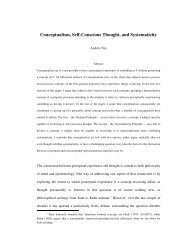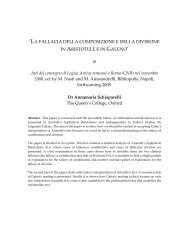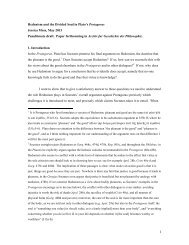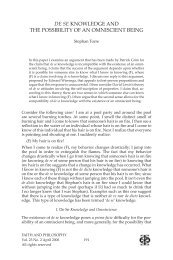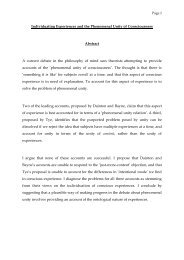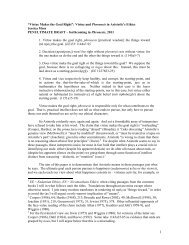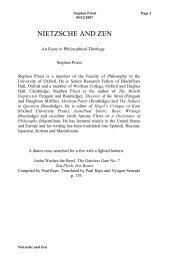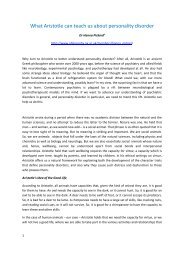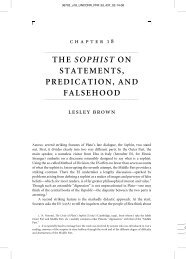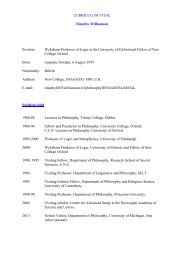Between Saying and Doing: Towards an Analytic Pragmatism
Between Saying and Doing: Towards an Analytic Pragmatism
Between Saying and Doing: Towards an Analytic Pragmatism
Create successful ePaper yourself
Turn your PDF publications into a flip-book with our unique Google optimized e-Paper software.
Br<strong><strong>an</strong>d</strong>om<br />
course, the cases we eventually care about—<strong><strong>an</strong>d</strong> will be discussing in the remaining lectures—<br />
involve vocabularies understood in a sense that includes their sem<strong>an</strong>tic signific<strong>an</strong>ce. But besides<br />
the adv<strong>an</strong>tages of clarity <strong><strong>an</strong>d</strong> simplicity, we will find that some import<strong>an</strong>t lessons carry over from<br />
the syntactic to the sem<strong>an</strong>tic case.<br />
The restriction to vocabularies understood in a restricted syntactic sense leads to<br />
correspondingly restricted notions of what it is to deploy such a vocabulary, <strong><strong>an</strong>d</strong> what it is to<br />
specify practices-or-abilities sufficient to deploy one. Suppose we are given <strong>an</strong> alphabet, which<br />
is a finite set of primitive sign types—for inst<strong>an</strong>ce, the letters of the English alphabet. The<br />
universe generated by that alphabet then consists of all the finite strings that c<strong>an</strong> be formed by<br />
concatenating elements drawn from the alphabet. So long as no upper bound is put on the length of the<br />
finite strings, the universe generated by <strong>an</strong>y finite alphabet, even one consisting of a single character, contains <strong>an</strong><br />
infinite number of strings: a, aa, aaa, <strong><strong>an</strong>d</strong> so on. A vocabulary over such <strong>an</strong> alphabet—in the syntactic<br />
sense I am now after—is then <strong>an</strong>y subset of the universe of strings that alphabet generates. If the<br />
generating alphabet is the English alphabet with punctuation including spaces, then the vocabulary<br />
might consist of all English sentences, or all possible English texts. 16<br />
What c<strong>an</strong> we say about the abilities that count as deploying a vocabulary in this spare<br />
syntactic sense? 17<br />
The abilities in question are the capacity to read <strong><strong>an</strong>d</strong> write the vocabulary. In<br />
this purely syntactic sense, ‘reading’ it me<strong>an</strong>s being able practically to distinguish, within the<br />
universe generated by the vocabulary, strings that do, from those that do not, belong to the<br />
16<br />
Computational linguists, who worry about vocabularies in this sense, have developed metal<strong>an</strong>guages for<br />
specifying import<strong>an</strong>t classes of such vocabularies: the syntactic <strong>an</strong>alogues of sem<strong>an</strong>tic metal<strong>an</strong>guages in the cases<br />
we will eventually address. So, for inst<strong>an</strong>ce, for the alphabet {a,b}, ‘a n b n ’ characterizes the vocabulary that<br />
comprises all strings of some finite number of ‘a’s followed by the same number of ‘b’s. ‘a(ba) * b’ characterizes the<br />
vocabulary that comprises all strings beginning with <strong>an</strong> ‘a’, ending with a ‘b’, <strong><strong>an</strong>d</strong> having <strong>an</strong>y number of repetitions<br />
of the sub-string ‘ba’ in between.<br />
17 Here we c<strong>an</strong> safely just talk about abilities, without d<strong>an</strong>ger of restricting the generality of the <strong>an</strong>alysis.<br />
LL1 Text.rtf 22 11/8/2007



